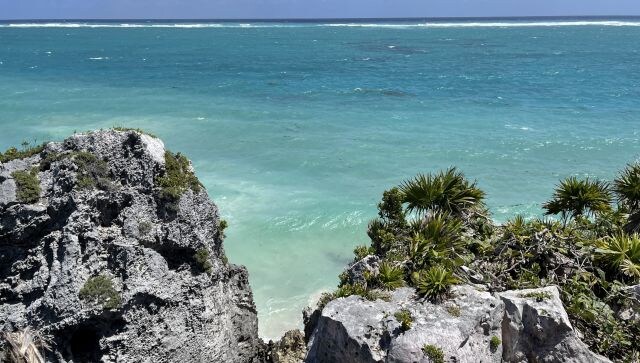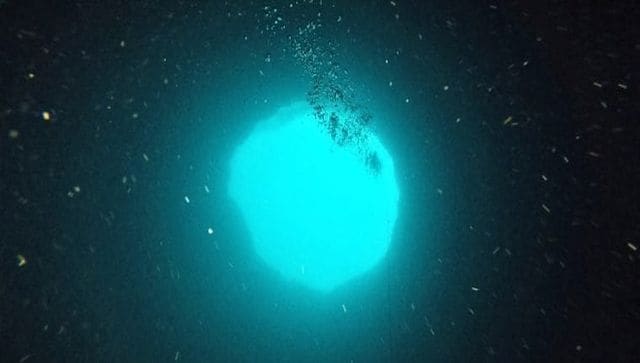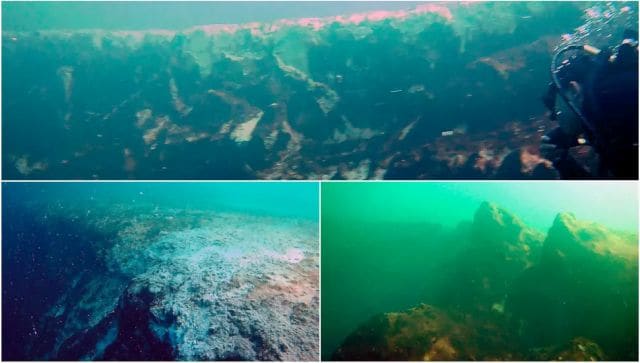World’s second-deepest blue hole found in Mexico: What is this undersea sinkhole and why is it so mysterious?

The second-deepest blue hole in the world has been discovered off the coast of the Yucatan Peninsula in Mexico. Representational picture/AFP
Did you know that black holes have cousins that appear in the ocean? They are mostly unexplored and many say they are a portal to ancient worlds. They are called blue holes. Now scientists have revealed that they have discovered the world’s second-deepest blue hole in Chetumal Bay, off the coast of the Yucatan Peninsula in Mexico.
What is a blue hole?
A blue hole is a massive underwater sinkhole that is hundreds of metres long, often the height of several skyscrapers and spanning areas that are bigger than cities.
They are believed to be formed during the latter ice ages around 11,000 years ago because of the erosion of limestone terrains. When seawater meets limestone, water easily permeates the rocks since they are so porous. This enables chemicals in the water to react with limestone, eating it away. Once glaciers melted and seawater rose over time, water rushed into these caverns and filled them up, creating these sinkholes.
Blue holes get their names from their indigo centres and light blue perimeters. They follow the rules of the ocean subject to tide, according to a report on Discovery.

What do we know about the blue hole in Chetumal Bay?
Known as Taam Ja, which means deep water, the blue hole in Chetumal Bay is about 900 feet deep. To give you some perspective, the Statue of Unity is 600 feet tall and World One, India’s tallest skyscraper in Mumbai with 76 storeys is 919 feet. The giant hole spans an area of 13,660 square metres.
While this sinkhole was originally discovered in 2021, it was only recently documented in the scientific journal Frontiers In Marine Science.
Taam Ja has steep sides with slopes of almost 80 degrees, and the mouth of the cavern sits around 15 feet below sea level, according to Live Science. It is the second-largest blue hole and just falls short of the record set by the deepest known one, the Dragon Hole in the South China Sea.

What do we know about Dragon Hole?
Dragon Hole is 987 feet deep, far deeper than the previous record holder, Dean’s Blue Hole in the Bahamas.
According to Xinhua, Dragon Hole is mentioned in the Ming dynasty novel Journey to the West, in which a supernatural monkey character gets a magical cudgel from an undersea kingdom ruled by a dragon.
While some blue holes like Dragon Hole open up to the marine environment others are inland.
Why are blue holes so mysterious?
Blue holes continue to be a mystery for scientists. They are hard to reach and hence not many have studied them.
“They are largely poorly understood,” Christopher G Smith, a coastal geologist at the US Geological Survey (USGS) who has studied other submarine sinkholes but was not involved in the latest research, told Live Science.
Blue holes are considered ecological hotspots with an abundance of plant and animal life. But interestingly, oxygen is scarce inside caves and sunlight is available only near the surface.
Life in these blue holes has adapted to the low-oxygen environment. It is fueled by the energy created by bacteria that use sulfate instead of oxygen during the process of photosynthesis, reports EarthSky.org.
These giant voids provide scientists with insight into what life on Earth was like millions of years ago when the planet was without oxygen. They could also tell us about life on other planets.
In 2012, researchers studying blue holes in the Bahamas found bacteria deep in the caverns where no other lifeforms dwelled. The DNA analysis of microbes from five different Bahamian blue holes found absolutely no shared species. Such findings could offer clues as to what life may exist in the extreme conditions elsewhere in our solar system, Live Science reports.
With inputs from agencies
Read all the Latest News, Trending News, Cricket News, Bollywood News,
India News and Entertainment News here. Follow us on Facebook, Twitter and Instagram.
For all the latest Sports News Click Here
For the latest news and updates, follow us on Google News.

